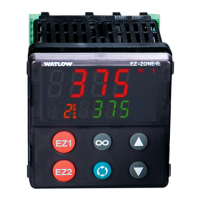Watlow EZ-ZONE
®
PMI Controller • 11 • Chapter 1 Overview
Internal Functions
The controller will use input signals to calculate a value and then perform an operation. A
sample of some functions may be as simple as:
• Compare an input value to the set point and calculate the optimal power for a heater
• Detect a failure of the primary sensing device and trip a contactor to remove power from
the heating element
• Reading a digital input to set a state to true or false
• Evaluate an incoming temperature to determine an alarm state (on or off)
To set up a function, it’s important to dene the source, or instance, to use. For example, if
the control is equipped with DIO they can be congured to respond to an alarm. If congured
as such, the digital output must be tied to the desired alarm instance (1 to 4). Using this as
an example, the Function for the digital output would be dened as an Alarm where the In-
stance would be selected as 1, 2, 3, or 4 corresponding to the alarm instance that will drive
the output.
Keep in mind that a function is a user-programmed internal process that does not execute
any action outside of the controller. To have any effect outside of the controller, an output
must be congured to respond to a function.
Outputs
Outputs can perform various functions or actions in response to information provided by a
function such as, removal of the control voltage to a contactor; operating a heater, turning a
light on or off, unlocking a door, etc...
Assign a Function to any available output on the Setup Page within the Output Menu or Digi-
tal Input/Output Menu. Then select which instance of that function will drive the selected
output. For example, you might assign an output to respond to alarm 4 (instance 4).
You can assign more than one output to respond to a single instance of a function. For ex-
ample, alarm 2 could be used to trigger a light connected to output 1 and a siren connected
to digital output 5.
Input Events and Output Events
Input and output events are internal states that are used exclusively by proles. The source
of an event input can come from a real-world digital input or an output from another func-
tion. Likewise, event outputs may control a physical output such as an output function block
or be used as an input to another function.
What is a Profile
A prole is a set of instructions consisting of a sequence of steps. When a prole runs, the
controller automatically executes its steps in sequence. The step type determines what ac-
tion the controller performs. Steps can change temperatures and other process values gradu-
ally over time, maintain the temperatures and process values for specic periods, or repeat
a sequence of steps numerous times. At each step the prole can activate or deactivate
outputs that control other equipment. Also a step can have the controller wait for specic
conditions before proceeding such as, waiting for a switch closure and/or a specic process
value to be detected by a sensor.

